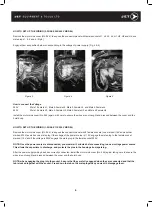
7
1.3.2. VOLTAGE OF POWER SUPPLY
• The voltage of the power supply should be within plus or minus 10% of rated voltage.
1.3.3. SUPPLY CABLE MUST BE THICK ENOUGH
• Too large a resistance (in Q) of the cable (or other power supply system) used between the power supply and the hoist will
cause the voltage to drop. It may not only damage the hoist but also give overheating of the supply cable. Choose such a
supply cable that the calculated voltage drop is less than 4V (or 2V in the case of 1-phase power supply).
HOW TO CALCULATE THE VOLTAGE DROP
3 - phase, foreseen voltage drop = 30.8 x L x I÷A ÷10000
1 - phase, foreseen voltage drop = 35.6 x L x I÷A ÷10000
Where
L = cable length (in m)
I = stationary current consumption (in A) (use the value shown on the name plate)
A = cross section of the cable (in mm
2
)
1.3.4. ALWAYS GROUND THE CHAIN HOIST
1.3.5. CONNECTING WORK OF OPERATING MODULE AND POWER SUPPLYING MODULE
• How to connect and install the above mentioned modules are explained in the instructions attached to them. Install them
correctly in accordance with the instructions.
1.3.6. REVERSE PHASE INSPECTION RELAY (For 3-phase model only)
• If the electric chain hoist does not work after connecting to the power
supply, the negative phase inspection relay has operated. In this case, DO
NOT MAKE ANY CHANGE TO THE HOIST’S WIRING in its body or in the
push button switch case. Reverse any 2 of the 3 wires in the main power
supply in order to disengage the negative inspection relay. (Fig.6)
1.3.7. DO NOT USE THE CHAIN HOIST IF:
• The hoist is not hung correctly from the top hook
• The vinyl band or caution tag attached to the load chain has not been removed
• The load chain is kinked or twisted
NOTE: the vinyl band is provided to keep the load chain in good condition during transportation. You should remove the
vinyl band after the hoist is located in the final working position and suspended correctly.
Figure 6




























